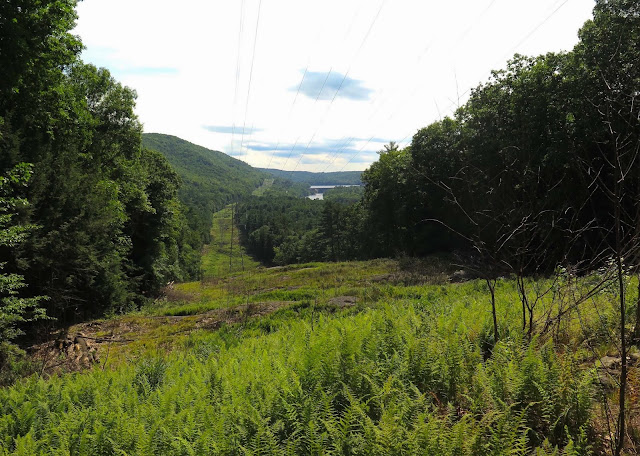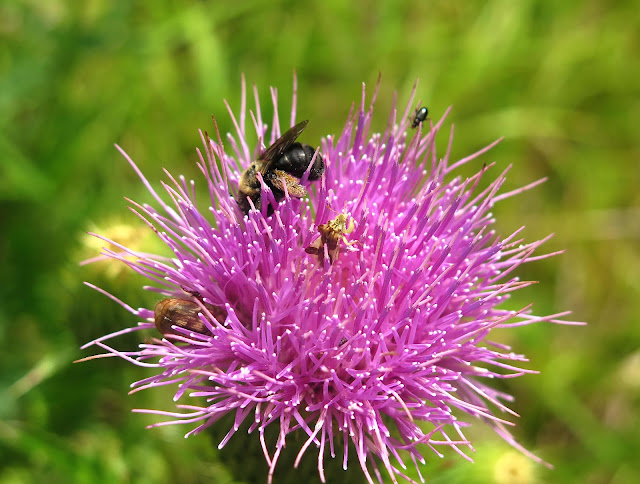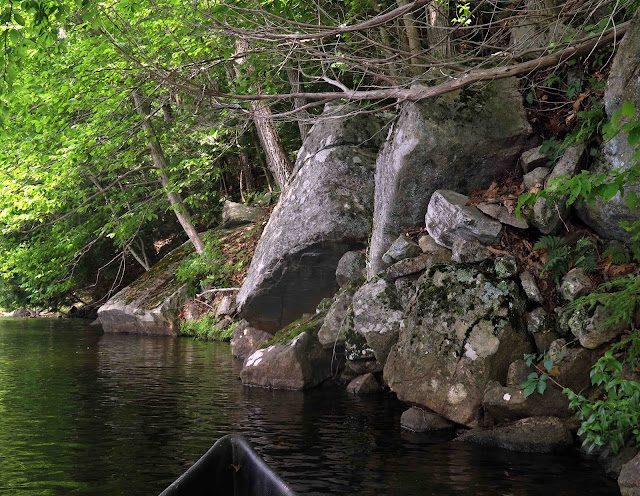I never turn down an opportunity to visit the Hudson River Ice Meadows. This remarkable stretch of riverbank north of Warrensburg, NY, is one of the richest botanical sites in the northeast, thanks to monumental heaps of a particular kind of frothy ice that piles up here to enormous heights in the winter, creating a habitat that many rare native species thrive in -- and most invasive species avoid. So when one of my Facebook Friends, a Cape Cod resident named Tom Walker, asked if I could show him this remarkable site during his vacation nearby, I promptly said, "Sure! Let's make a date!" That's Tom in the photo below, as he stepped onto the east bank of the Hudson Ice Meadows.
We arranged to meet on both Thursday and Friday this past week, a day each for visiting the east and west banks of the Hudson River Ice Meadows.
The Hudson River Ice Meadows, East Bank
As we stepped from the pine woods onto the east-bank shore, one of the first plants we encountered was New Jersey Tea (Ceanothus americanus), a common shrub in this region but one that Tom had never encountered in his coastal home territory. By this time of the summer, most of this shrub's clusters of tiny white flowers have turned to clusters of shiny dark-red seeds, creating another way of being beautiful.
But we also found some other New Jersey Tea shrubs still in beautiful white bloom. Here, those shrubs share a riverside bank with the spectacularly colorful Butterflyweed (Asclepias tuberosa).
To me in my home surroundings, the Woodland Sunflower(Helianthus divaricatus) is almost as common as Dandelions, but Tom told me it was a species he'd never yet seen on Cape Cod. That made me glad I pointed it out, noting its distinctive feature, its leaves meeting the stems with virtually no leafstalks.
Then, here was a plant that had been unknown to me until just last year, when a botanist had corrected me when I identified it as our common Frostweed (Crocanthemum canadense). No, he told me, this is the species called Hoary Frostweed (C. bicknellii), and he pointed out that the flowers occurred multiply, in terminal clusters, instead of as a solitary bloom surmounted by terminal leaves. He also pointed out that C. bicknellii is somewhat bushier in appearance and blooms a bit later than C. canadense. This particular Hoary Frostweed had a Crab Spider lurking within, waiting for its white coloration to change to a more camouflage-effective yellow.

True to the "meadows" part of the Ice Meadows' name, many of the plants that grow here in the flat sunny areas are grasses and sedges typical of a grassland. This Turkey-foot Grass (Andropogon gerardi) is one of the tallest and most abundant, and today it was particularly beautiful, strung with dainty yellow staminate flowers that shimmied in the breeze. The tiny white bottlebrush-shaped pistillate flowers were also evident. This species is also know as Big Bluestem Grass.
Considering how abundantly this next plant thrives at this site, it is truly hard to believe that this sedge called Whip Nut Rush (Scleria triglomerata) could actually be rated as an Endangered species in New York and other northeastern states. But this open, sandy, seasonably wet habitat is exactly the kind of site it must have, and it has that here in spades, thanks to the annual ice heaps suppressing the woody plants that would otherwise encroach on this sunlit shoreline.
The multicolored pearl-shaped seeds are a distinctive trait of Whip Nut Rush, ranging from porcelain white through shiny green to pure black.
The rusty-colored Smooth Saw-sedge (Cladium mariscoides) is another abundant sedge at this site, but this one grows close to the water's edge, even out in standing shallow water. It usually prefers habitats high in calcium, a mineral supplied by outcroppings of marble just upstream along these shores.
While we were examining these waterside plants, we were visited by this Green Frog, vividly green and marked with dark dots. I wonder if it mistakenly believed its markings were good camouflage, since it held remarkably still for the picture-taking.
This wee little American Toad, no bigger than a cricket, did NOT hold still for the picture-taking, hopping away each time just as I pushed my camera's shutter button. But somehow I managed to get one reasonably clear shot of it. So cute!
As we moved upstream, we approached a section of riverbank remarkable for large outcroppings of marble.
While most of the marble was a shimmering white, some was colored various shades of green. And constant erosion from spring floods and winter icing had caused many of these crystals to break up into small chunks, easily gathered by the handful.
Since marble is metamorphosed limestone, many of the plants that thrive in this section are definite lime-lovers. Rock Sandwort (Sabulina michauxii) is one of those lime lovers, studding these marble banks with mounds of needle-fine leaves high up close to the neighboring woods. Since this plant was now nearing the end of its blooming time, we were lucky to find just a few of its pretty white flowers. Since this species, while ostensibly secure in New York, is quite rare in New England states, I was glad I could show it to Tom, who is not likely to find it in his home state of Massachusetts.
Shrubby Cinquefoil (Dasiphora fruticosa) is such a commonly cultivated garden shrub, it might be hard to think of it as a native wild shrub, but the specimens that thrive on these marble shores are just that, native wild shrubs taking advantage of the richly calcareous habitat provided by all that marble.
Now, this next flower was indeed a surprise! For one thing, Wood Lilies (Lilium philadelphicum) have long finished blooming where I live 20 miles south in Saratoga County. But then I recall that all those heaps of ice often don't melt away until mid June at this site, chilling the soil and delaying spring bloomers. But also, I find this species of lily only in sandy low-nutrient sites where I live, and this site is known for lime-rich soil. Except that these lilies were growing high up on the banks, well away from the marble outcroppings. They were also surrounded by New Jersey Tea and Lowbush Blueberries, two shrubs that are frequently found in low-nutrient, more acidic habitats.
One of the truly remarkable characteristics of both Ice Meadows shores is the close proximity of both acidic and calcareous habitats. That was truly the case as well for the west-bank section we visited the following day.
The Hudson River Ice Meadows, West Bank
On Thursday, Tom and I had been driven from the east bank of the Hudson a bit earlier than we'd hoped by a sudden torrential downpour. But Friday proved to be dry and sunny all day for our second excursion together, this time to the west bank of the Hudson Ice Meadows. A second added pleasure was the company of my friend Sue Pierce, who also knows Tom as a Facebook Friend. The two, pictured below, also share a passion for photographing "odes," the damsel- and dragonflies that flit about this remarkable shoreline, and so they had more than a passion for plants in common, and spent almost as much time pursuing their elusive subjects as they did botanizing.
This section of the Ice Meadows is remarkable for the presence of many spring-fed pools, a situation that delivers lime-rich waters among granitic rocks that support the presence of plants less dependent on basic soils.
That particular habitat is perfect for Sticky False Asphodel (Triantha glutinosa), a state-ranked Endangered species that prefers rich fens and calcareous peaty swamps. Reported from only four counties in New York State, this plant is certainly happy at this site, where it grows so abundantly we had to watch where we placed our steps. Its former tufts of small white flowers had now produced shiny red seedpods that were easy to spot among the damp rocks and thickly growing greenery.
This wetland habitat is also preferred by the tiny-flowered Yellow-eyed Grass (Xyris sp.). The chances are good that the one pictured here is the rarer Threatened species, Xyris torta, instead of the more common X. montana. On a visit a year ago with noted botanist David Werier, he closely examined the ones growing in the same pool where I found this one and determined that it was, indeed, Xyris torta, the Slender Yellow-eyed Grass.
These tiny weak-stemmed flowers, called Marsh -- or Bedstraw -- Bellflower (Campanula aparanoides), are much more common than Xyris in wet areas throughout the state, although they are often overlooked because they often hide among other plants. I was lucky to find this lovely little clump growing out of a crack in the rock, much easier to photograph than those obscured by surrounding greenery elsewhere.
More tiny flowers clinging to spring-dampened rocks, the white ones belonging with the glittering red leaves of Spatulate-leaved Sundew (Drosera intermedia) and the yellow ones to a few plants of Canada St. John's Wort (Hypericum canadense) mixed in.
Horned Bladderwort (Utricularia cornuta) is another denizen of these rocky pools and the sandy rivershore.
This odd-looking growth had me puzzled for a bit until I remembered finding it once before in a similar habitat on another stretch of the Hudson: bare rock that gets occasionally wetted. This is a lichen called Dermatocarpon luridum. One of its several vernacular names is Streamside Stippleback, which suggests the lichen's need to be close to water. When not wetted, it looks like black crumbles instead of this green leafy-looking stuff.

More green leafy growth, but these green long-tapered leaves belong to one of the rarest plants in the entire northeast, the New England Violet (Viola novae-angliae), ranked as Endangered in New York State. The cracks and crevices of the annually flooded bedrock along both banks of these Ice Meadows provide the only known sites in all of New York where this violet is known to grow. And it grows quite happily here. Oddly enough, despite its name, it is absent from every New England state except for Maine, where it is also very rare. It has beautiful deep-purple flowers in May, and its leaves persist throughout the summer.

The strong peppermint smell of this Virginia Mountain Mint (Pycnanthemum virginianum) told me of its presence before I actually saw it, as one of my friends must have brushed against it and crushed a leaf in the process. This species has somewhat broader and much hairier leaves than the Narrow-leaved Mountain Mint I am more familiar with, but the two species have very similar small white purple-polka-dotted florets that sprout in clusters from chubby involucres.
And here was the floral beauty queen of our botanical finds: the exquisite Small Purple Fringed Orchid (Platanthera psycodes), still holding the promise of even more beauty with its many unopened buds. You'd think I could spot this showy flower from a hundred yards away, but I had walked right past where it was hidden among the tall grass. Luckily, my super-spotter pal Sue detected it and hollered for us to come see it. This one, and yet another one almost as beautiful close by. Not a rare plant, but it sure was a prize!

Beginning to weary of leaping and climbing and teetering over boulders, I sat on a rocky ledge to rest my achy arthritic knee while Tom and Sue pursued some elusive insects. And what a place to perch! Blue sky above, blue water below, deep-green forest on either side, not a sound from human occupation to intrude on the soothing music of rushing rapids. I feel truly blessed that my world contains such beautiful unspoiled places to explore, and also such delightful friends to explore them with.












































































